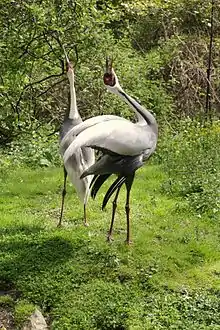White-naped crane
The white-naped crane (Antigone vipio) is a bird of the crane family. It is a large bird, 112–125 cm (44–49 in) long, about 130 cm (4.3 ft) tall, and weighing about 5.6 kg (12 lb), with pinkish legs, a grey-and-white-striped neck, and a red face patch.
| White-naped crane | |
|---|---|
 | |
| White-naped crane at Saijo, Ehime, Japan | |
| Scientific classification | |
| Kingdom: | Animalia |
| Phylum: | Chordata |
| Class: | Aves |
| Order: | Gruiformes |
| Family: | Gruidae |
| Genus: | Antigone |
| Species: | A. vipio |
| Binomial name | |
| Antigone vipio (Pallas, 1811) | |
The white-naped crane breeds in northeastern Mongolia, northeastern China, and adjacent areas of southeastern Russia, where a program at Khingan Nature Reserve raises eggs provided from U.S. zoos to bolster the species. Different groups of the birds migrate to winter near the Yangtze River, the Korean Demilitarized Zone, and on Kyūshū in Japan. They also reach Kazakhstan and Taiwan. Only about 4,900 to 5,400 individuals remain in the wild.
Its diet consists mainly of insects, seeds, roots, plants, and small animals.
Due to ongoing habitat loss and overhunting in some areas, the white-naped crane is evaluated as vulnerable on the IUCN Red List of Threatened Species.[1] It is listed on Appendix I and II of CITES. In South Korea, it has been designated natural monument 203.
The white-naped crane was formerly placed in the genus Grus, but a molecular phylogenetic study published in 2010 found that the genus, as then defined, was polyphyletic.[2] In the resulting rearrangement to create monophyletic genera, four species, including the white-naped crane, were placed in the resurrected genus Antigone that had originally been erected by German naturalist Ludwig Reichenbach in 1853.[3][4]
 A mated pair performing a "unison call", which strengthens the pair bond and provides a territorial warning to other cranes.
A mated pair performing a "unison call", which strengthens the pair bond and provides a territorial warning to other cranes. Juvenile
Juvenile Adult and egg
Adult and egg Head
Head
References
- BirdLife International (2012). "Grus vipio". IUCN Red List of Threatened Species. 2012. Retrieved 26 November 2013.CS1 maint: ref=harv (link)
- Krajewski, C.; Sipiorski, J.T.; Anderson, F.E. (2010). "Mitochondrial genome sequences and the phylogeny of cranes (Gruiformes: Gruidae)". Auk. 127 (2): 440–452. doi:10.1525/auk.2009.09045.
- Gill, Frank; Donsker, David, eds. (2019). "Flufftails, finfoots, rails, trumpeters, cranes, limpkin". World Bird List Version 9.2. International Ornithologists' Union. Retrieved 26 June 2019.
- Reichenbach, Ludwig (1853). Handbuch der speciellen Ornithologie. Leipzig: Friedrich Hofmeister. p. xxiii.
External links
![]() Media related to Grus vipio at Wikimedia Commons
Media related to Grus vipio at Wikimedia Commons
- BirdLife Species Factsheet
- International crane Foundation
- White-naped Crane (Grus vipio) from Cranes of the World (1983) by Paul Johnsgard
